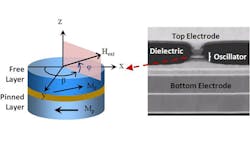Is An Oscillator Upgrade On The Horizon?
Cell phones, WiFi-enabled tablets, and other electronic devices all incorporate oscillators, which are traditionally silicon-based structures that generate signals by means of an electron-charge mechanism. Recently, however, a team of researchers from the University of California, Los Angeles (UCLA)—ZhongmingZeng, Pedram KhaliliAmiri, Ilya N.Krivorotov, HuiZhao, GiovanniFinocchio, Jian-PingWang, Jordan A.Katine, YimingHuai, JuergenLanger, KosmasGalatsis, Kang L.Wang, and HongWenJiang—have developed a new type of oscillator that utilizes the spin of an electron. This development could potentially pave the way for cheaper, more energy-efficient mobile communication devices that deliver much better signal quality.
The new oscillators grew out of research at the UCLA Henry Samueli School of Engineering and Applied Science, which had been sponsored by the Defense Advanced Research Projects Agency (DARPA). The researchers’ focus was originally on spin-transfer torque magnetoresistive random access memory (STT-RAM), which has demonstrated several advantages over other types of computer memory. But in the process, they realized that STT-RAM’s layered nanoscale structures could also be developed for microwave oscillators, and utilized in communications applications.
These structures, known as spin-transfer nano-oscillators (STNOs), are composed of two distinct magnetic layers: One has a fixed magnetic polar direction, while the other’s can be made to gyrate in response to an electric current (see figure). This allows the structure to produce very precise and stable microwave oscillations. The SNTO was tested to show output power of close to 1 μW, with a record narrow signal linewidth of 25 MHz.
In addition, the new nanoscale system is about 10,000 times smaller than current silicon-based oscillators. The nano-oscillators can easily be incorporated into existing integrated circuits (ICs), as they are compatible with current IC fabrication techniques. Best of all, the oscillators can be used in both analog and digital communications, which means smartphones can take full advantage of them.
The researchers’ findings can be reviewed in the article “High-Power Coherent Microwave Emission from Magnetic Tunnel Junction Nano-oscillators with Perpendicular Anisotropy,” which has been published online in the journal ACSNano (http://pubs.acs.org).
